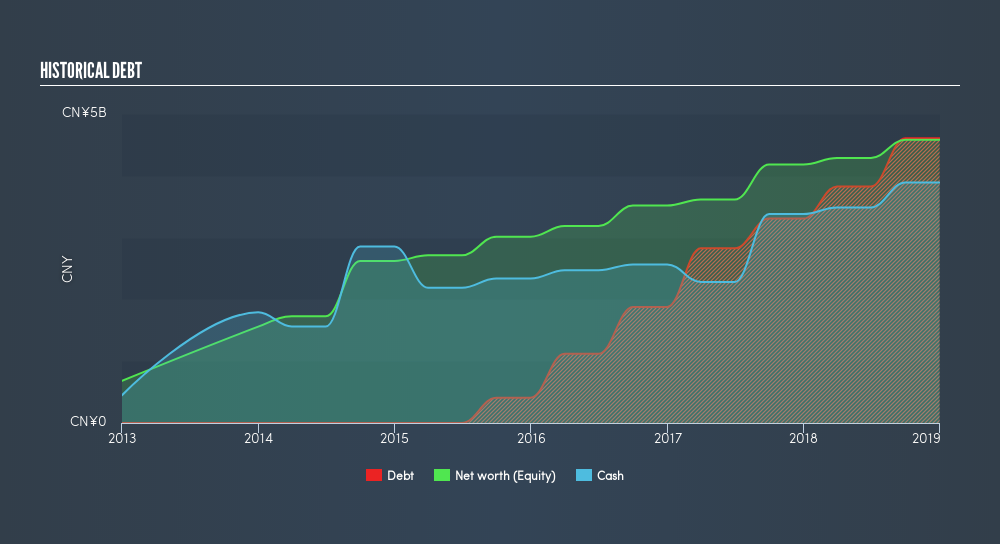- Hong Kong
- /
- Construction
- /
- SEHK:1599
We Think Beijing Urban Construction Design & Development Group (HKG:1599) In Taking Some Risk With Its Debt

Want to participate in a short research study? Help shape the future of investing tools and you could win a $250 gift card!
David Iben put it well when he said, 'Volatility is not a risk we care about. What we care about is avoiding the permanent loss of capital.' So it seems the smart money knows that debt - which is usually involved in bankruptcies - is a very important factor, when you assess how risky a company is. As with many other companies. Beijing Urban Construction Design & Development Group Co., Limited (HKG:1599) makes use of debt. But the more important question is: how much risk is that debt creating?
When Is Debt A Problem?
Generally speaking, debt only becomes a real problem when a company can't easily pay it off, either by raising capital or with its own cash flow. If things get really bad, the lenders can take control of the business. However, a more usual (but still expensive) situation is where a company must dilute shareholders at a cheap share price simply to get debt under control. Of course, debt can be an important tool in businesses, particularly capital heavy businesses. The first thing to do when considering how much debt a business uses is to look at its cash and debt together.
View our latest analysis for Beijing Urban Construction Design & Development Group
How Much Debt Does Beijing Urban Construction Design & Development Group Carry?
The image below, which you can click on for greater detail, shows that at December 2018 Beijing Urban Construction Design & Development Group had debt of CN¥4.61b, up from CN¥3.31b in one year. However, it also had CN¥3.89b in cash, and so its net debt is CN¥714.0m.

How Healthy Is Beijing Urban Construction Design & Development Group's Balance Sheet?
According to the last reported balance sheet, Beijing Urban Construction Design & Development Group had liabilities of CN¥7.32b due within 12 months, and liabilities of CN¥4.50b due beyond 12 months. Offsetting these obligations, it had cash of CN¥3.89b as well as receivables valued at CN¥5.88b due within 12 months. So its liabilities total CN¥2.05b more than the combination of its cash and short-term receivables.
This deficit is considerable relative to its market capitalization of CN¥2.82b, so it does suggest shareholders should keep an eye on Beijing Urban Construction Design & Development Group's use of debt. This suggests shareholders would heavily diluted if the company needed to sure up its balance sheet in a hurry. Because it carries more debt than cash, we think it's worth watching Beijing Urban Construction Design & Development Group's balance sheet over time.
We measure a company's debt load relative to its earnings power by looking at its net debt divided by its earnings before interest, tax, depreciation, and amortization (EBITDA) and by calculating how easily its earnings before interest and tax (EBIT) cover its interest expense (interest cover). This way, we consider both the absolute quantum of the debt, as well as the interest rates paid on it.
Beijing Urban Construction Design & Development Group has a low debt to EBITDA ratio of only 1.15. But the really cool thing is that it actually managed to receive more interest than it paid, over the last year. So it's fair to say it can handle debt like a hot shot teppanyaki chef handles cooking. And we also note warmly that Beijing Urban Construction Design & Development Group grew its EBIT by 13% last year, making its debt load easier to handle. The balance sheet is clearly the area to focus on when you are analysing debt. But ultimately the future profitability of the business will decide if Beijing Urban Construction Design & Development Group can strengthen its balance sheet over time. So if you want to see what the professionals think, you might find this free report on analyst profit forecasts to be interesting.
Finally, a business needs free cash flow to pay off debt; accounting profits just don't cut it. So we clearly need to look at whether that EBIT is leading to corresponding free cash flow. During the last three years, Beijing Urban Construction Design & Development Group burned a lot of cash. While investors are no doubt expecting a reversal of that situation in due course, it clearly does mean its use of debt is more risky.
Our View
Neither Beijing Urban Construction Design & Development Group's ability to convert EBIT to free cash flow nor its level of total liabilities gave us confidence in its ability to take on more debt. But its interest cover tells a very different story, and suggests some resilience. Taking the abovementioned factors together we do think Beijing Urban Construction Design & Development Group's debt poses some risks to the business. While that debt can boost returns, we think the company has enough leverage now. Another positive for shareholders is that it pays dividends. So if you like receiving those dividend payments, check Beijing Urban Construction Design & Development Group's dividend history, without delay!
If, after all that, you're more interested in a fast growing company with a rock-solid balance sheet, then check out our list of net cash growth stocks without delay.
We aim to bring you long-term focused research analysis driven by fundamental data. Note that our analysis may not factor in the latest price-sensitive company announcements or qualitative material.
If you spot an error that warrants correction, please contact the editor at editorial-team@simplywallst.com. This article by Simply Wall St is general in nature. It does not constitute a recommendation to buy or sell any stock, and does not take account of your objectives, or your financial situation. Simply Wall St has no position in the stocks mentioned. Thank you for reading.
About SEHK:1599
Beijing Urban Construction Design & Development Group
Provides various professional services for urban construction in China and internationally.
Established dividend payer and good value.
Market Insights
Community Narratives





